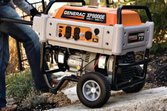
A lower-priced alternative to standby generators, portable generators can keep power running in an emergency, as long as you don’t mind a few inconveniences.
A storm has knocked out power to your neighborhood, but you need to use your computer for work today. A portable generator might be the fastest way to whirl back into action.
Unlike a large, permanently installed standby generator, a portable backup unit requires less money up front — about $500 to $2,000, versus $4,000 and up for standby power. It’s also easier to get up and running. You can purchase one online, from a local lawn-equipment dealer, or at a big-box store. Then simply drive it home and store it in the garage or shed.
In an emergency, wheel it out, gas it up, pull the starter cord, and you’ve got your own mini electric plant. These units are not without their downsides, chief among them that you have to be home to operate them. But if you’re in the market for backup power and trying to decide what kind is right for you, here are the questions to ask.
Is price the deciding factor? If yes, go portable
The main appeal of a portable generator over a standby is savings. You can buy a good 3kW unit for under $500, an 8kW for $1,500 to $2,000 and a 10kW for about $2,000. Prices vary depending on where you buy it and what brand you choose. Leading manufacturers include Briggs & Stratton, Subaru, Honda, and Generac.
Installation and operating costs are minimal—mostly the cost of fuel. Cheapest is “pour and plug”: You haul out the generator, pour in the gas, and plug in extension cords you’ve run from essential appliances like the computer, lamps, and refrigerator.
Slightly more expensive but more convenient is to hire an electrician to run a 220-volt line from your circuit breaker panel to a receptacle installed outside, a task that takes a couple of hours and costs a couple hundred dollars. That way, in the event of an emergency you can plug the generator into the receptacle and switch on the circuits you need.
How much power do you need? If not much, portable’s okay
Portable units for home use provide anywhere for 3kW to10kW of power. That’s enough to run some household essentials—as long as your “essentials” don’t include the plasma TV, central air conditioner, and Jacuzzi tub. “You can probably run a water pump, a heater, some lights, and your refrigerator with a 5kW to 8kW unit,” says Chris Sauer, owner of G & G Lawn and Power in Stone Ridge, NY.
You could go bigger, but operating a high-powered portable can get difficult and carries some risks. Which brings us to the next question:
How much risk are you comfortable with? If some, consider portable
A portable generator sits within extension-cord range of the house, chugging away like a little car. And like a car, it gives off smelly exhaust fumes, heat, and noise. If not properly ventilated, a portable could cause a fire or carbon monoxide poisoning.
“You’ve got to monitor the system very closely,” says Jack Minick, a field representative with the National Electrical Manufacturers Association (NEMA) and specialist in disaster recovery. “I set mine in front of my garage door, where I have limited extension cords, and inside, we’re very careful.”
How much inconvenience can you take? If a fair amount, consider portable
Your generator’s gas tank will hold, on average, from three to six gallons, meaning you’ll need to run outside to refill it, even if it’s 10 degrees below zero and snowing. It can take 34 gallons of gas to run an average-size portable for two days.
Because gasoline can “gum up” if left standing too long, there’s always a chance that your portable generator won’t start, much like that other finicky piece of gas-powered equipment, the lawnmower. Luckily, there’s no such thing as a lawn-mowing emergency. But you’ll have to exercise your generator by starting it up a couple of times a year to make sure it will run when you need it.
Will you be around during a power outage? If not, a portable’s not for you
Unlike a standby generator, a portable requires people power, too. If you’re not home to turn it on after a hurricane, it’s just another hunk of metal in your slowly flooding garage.
Still, with all the inconveniences, a portable generator delivers just what many homeowners want—emergency backup power at a reasonable cost. “I spent $1,000 rather than the $8,000 I’d have spent on a standby unit,” says Sauer. “If the power goes out, I can just wheel it out and get it going.”
For more about using a portable generator, read our blog post about lessons learned on using a portable generator.



